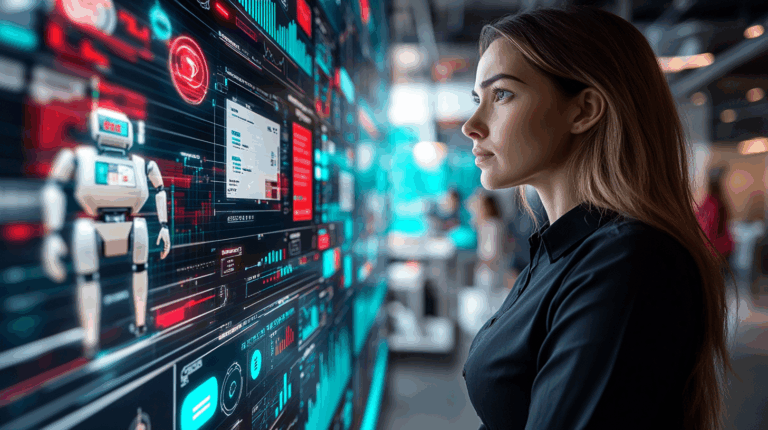In a world where technology is advancing at an exponential pace, a new protagonist—or perhaps antagonist—is taking center stage. ChatGPT, a representation of AI’s ever-advancing prowess, is no longer confined to the digital playground; it’s venturing into the real world, targeting the roles once considered secure havens for junior workers. ChatGPT has the potential to replace some junior jobs that involve repetitive or low-skill tasks, such as data entry, content writing, basic coding, etc. Many juniors therefore perceive AI as a threat to their livelihood and career.
Consider this: 48% of companies employing ChatGPT have already witnessed it replace human roles, with the specter of more layoffs looming on the horizon. For instance, IBM has announced plans to replace 8,000 jobs with AI, showcasing a tangible shift towards automation in major corporations.
Yet, amidst the challenges, opportunities for growth and adaptation also arise. Reskilling emerges as a beacon of hope, a pathway to survival and success in an age where machines mirror human abilities. This blog explores the complex interplay of replacement, adaptation, and evolution in the workplace, where the lines between human ingenuity and technological prowess are increasingly blurred.
The Impact of ChatGPT on Junior Roles
The once fantastical idea of robots replacing humans in the workplace is becoming a reality again, following the last time in the industrial revolution. In recent months, we’ve witnessed the rise of AI technologies and Large Language Models like ChatGPT that perform tasks once reserved for humans. The junior workforce, often engaged in roles requiring less sophistication, is feeling the pinch.
ChatGPT, in its current release, can perform a lot of useful tasks, for example: Automate tasks and workflows such as scheduling meetings, generating reminders, managing emails, and so on. Furthermore, it functions as a search engine to help users find relevant information and can conduct trivia quizzes to test users’ knowledge on various topics such as history, geography, science, etc. Lastly, its creative writing capabilities enable users to generate poems, stories, lyrics, and more.
In the realm of technology, even entry-level coders are not immune to the advancements in AI. ChatGPT is not merely a tool; it’s a virtual entity that could be viewed as a candidate for an entry-level coding position. With the ability to understand complex algorithms, generate code snippets, and learn from user inputs, its capabilities mirror some of the tasks expected from human coders. While it can’t replace the intuitive human touch, its proficiency in repetitive tasks and fetching the right code for a problem raises serious questions about the future landscape of the coding profession.
Beyond the coding world, other professions are feeling the ripples of AI intrusion. Copywriters, once reliant on the irreplaceable human gift of creativity, are now contending with AI like ChatGPT that can craft content, adapt writing styles, and even come up with brand names and slogans. Translators too are faced with AI tools that can fluently translate between languages. The creative industry, once considered the last bastion of human exclusivity, is now at the crossroads where technology and creativity meet, often in conflicting ways.
Even content moderation roles, which were thought to require human judgment, are under the spotlight. ChatGPT and other AI models can sift through vast amounts of content, filtering out inappropriate material — textual, audio, or visual — with cold precision. While the efficiency is unparalleled, the subtle understanding of context and cultural nuances might be lost. Here, the balance between human discernment and machine efficiency becomes a critical conversation, as we weigh the pros and cons of automation in a field that requires both empathy and accuracy.
The integration of AI like ChatGPT in the workplace brings to the fore a complex dynamic that demands a thoughtful approach. How we navigate this terrain will determine not only the future of many professions, but also the very essence of human work in an increasingly automated world.
The Wage War: Understanding Economic Implications
It’s no secret that the adoption of AI like ChatGPT is reducing costs for businesses. By replacing human workers with bots, companies are cutting down on salaries and other related expenses. The drive for efficiency is compelling, but the economic implications are far-reaching. Lower wages and fewer opportunities for junior roles have a ripple effect across the economy. From decreased spending power to increased income inequality, the impact of AI’s takeover is more profound than mere numbers on a spreadsheet. The reality of 47% of US jobs potentially being automated by 2033 is a stark reminder of the urgency to address this issue.
The human cost of this technological revolution is real and the societal implications demand careful consideration. It’s not just about automation leading to unemployment; even those clinging to their jobs could face reduced wages. With AI like ChatGPT creating more competition in the job market, downward pressure on wages becomes an alarming possibility. A report from OpenAI, the company that created ChatGPT, found that the newest artificial intelligence could affect white-collar workers more than the rest of the workforce. Any job that uses computers as a main tool would see AI impact it in a more profound way. Oddly enough, hands-on, labor intensive jobs that are considered less modern are also less likely to disappear soon.
The need for a nuanced approach is evident. Balancing technological innovation with social responsibility is not just an ethical obligation; it’s a business imperative. It’s a call to action for businesses, policymakers, and society as a whole to engage in thoughtful dialogue and strategic planning. As we forge ahead in this age of automation, understanding and navigating these economic implications will be paramount to ensuring a balanced and inclusive future.
Adapting to Change: Bridging the Automation Gap through Reskilling and Continuous Learning
In this high-tech era, there’s a growing realization that adaptation is the key to survival. While AI technologies like ChatGPT are replacing juniors in some roles, the narrative is not entirely one of displacement. Reskilling and continuous learning are becoming central to maintaining a relevant workforce and this is where the real challenge and opportunity lie. But what does this mean for juniors, and how can they stay ahead of the curve? It means recognizing that reskilling is not just a buzzword; it’s a tangible, actionable pathway that can bridge the gap between automation and human relevance. Juniors and other work seekers should learn the jobs that are in need in an AI era, including the jobs that are needed to program AI, treat it, and enhance it.
Organizations, governments, and educational institutions must play a part in preparing the workforce for this new reality. Offering opportunities for reskilling, whether inside the company through training and mentoring programs or externally through boot camps, courses, or certificates, can ensure that humans not only survive but thrive in the age of AI. Education providers like Wawiwa, illustrate how reskilling is becoming a global priority, leveraging innovative training methodologies to enable people to adapt and grow in this environment.
Soft skills also play an important role. Emphasizing human values, nurturing creativity, critical thinking, and adaptability, can help in forging a path that doesn’t leave juniors behind. It’s not about resisting technology; it’s about harmonizing with it and leveraging our unique human qualities to maintain relevance. The wave of automation, spearheaded by tools like ChatGPT, doesn’t necessarily spell doom for the workforce. Instead, it calls for a shift in mindset, a willingness to embrace change, and a commitment to lifelong learning. By understanding and actively participating in this transformation, we can build a future where technology complements human ingenuity, rather than competes with it. The role of training, reskilling and upskilling becomes a proactive strategy to ensure that technology and humanity coexist in a mutually beneficial ecosystem.
The Importance of Ethical Considerations
The rise of AI, particularly in replacing junior roles, is not merely a technological or economic issue; it’s profoundly ethical. How we choose to integrate AI into our workplaces reflects our values and our vision for the future. This integration must be done with full awareness of the possible consequences, recognizing that AI’s potential benefits are intertwined with significant ethical considerations.
Accountability and Responsibility
Ensuring AI systems are transparent, explainable, and accountable for their actions and outcomes is paramount. Clear guidelines must be established to assign responsibility for any harms or errors AI systems may cause. Ignoring the human cost in favor of efficiency and profit can lead to societal discord and increased inequality. An ethical approach that considers these broader implications and seeks a balanced path is not just morally right; it’s strategically sound. Accountability measures help build trust in AI systems and assure the public that technology will be used responsibly. It starts with a simple understanding, if no juniors enter a company, there would be no succession to the older generations as they retire (or replaced by AI later on) and the company would perish.
Fairness and Equality
AI’s potential to discriminate or exclude people based on personal or social characteristics must be actively prevented or mitigated. Guidelines must be in place to ensure that everyone has equal access and opportunity to benefit from AI. Fairness in AI goes beyond legal compliance, aiming for a more profound commitment to social justice and inclusion. Ensuring that AI systems are designed and implemented without bias is a continuous challenge that demands vigilance and commitment.
Human Dignity and Autonomy
Respecting and protecting people’s dignity, privacy, and freedom of choice is fundamental when AI systems collect, use, or influence personal data or behavior. Embracing technology without losing sight of our humanity is a challenge that we must meet head-on. Engaging in thoughtful dialogue, crafting responsible policies, and making decisions that honor both innovation and human dignity can guide us through this complex terrain. The way we approach AI’s role in our lives reflects our societal values and sets the tone for a future where technology serves humanity rather than undermines it.
This comprehensive view of the ethical dimensions of AI’s integration into the workforce goes beyond abstract principles. It calls for concrete actions, shared responsibility, and a collective commitment to ensuring that the rapid advances in technology align with our deepest human values and social priorities. It’s a path that leads not only to technological progress but to a more just and humane future.
Conclusion
The intersection of technology and human ingenuity in the era of AI is an intricate landscape filled with both promise and peril. While AI technologies like ChatGPT present remarkable opportunities for efficiency and innovation, they also cast a shadow over junior roles, challenging the very fabric of the workforce. From the creative industry to economic landscapes and educational paradigms, the integration of AI is a multifaceted phenomenon that demands not just technological mastery but thoughtful, ethical stewardship.
As we stand at the crossroads of automation and human relevance, the path forward is neither predetermined nor linear. It requires a nuanced understanding of the complex dynamics at play, a willingness to engage in continuous learning, and a commitment to ethical considerations. Emphasizing reskilling, nurturing creativity, balancing innovation with social responsibility, and harmonizing with technology rather than resisting it, are pivotal steps in shaping a future where AI complements rather than competes with human intelligence. It is in this harmonious coexistence that we may find the true potential of the technological revolution, preserving the dignity of human work and fostering an inclusive, sustainable future.
The impact of ChatGPT and similar AI technologies on junior roles is a tale not merely of replacement but of evolution. The challenge lies not in the technology itself but in how we choose to navigate its adoption. Reskilling and upskilling to job roles that create AI, leverage AI, and improve it are valid strategies for making a career in this new era. Through collaboration, foresight, empathy, and strategic planning, we can write a narrative that honors both technological progress and the timeless value of human creativity and spirit. In this delicate balancing act lies the key to unlocking a new era of innovation, prosperity, and shared growth.



